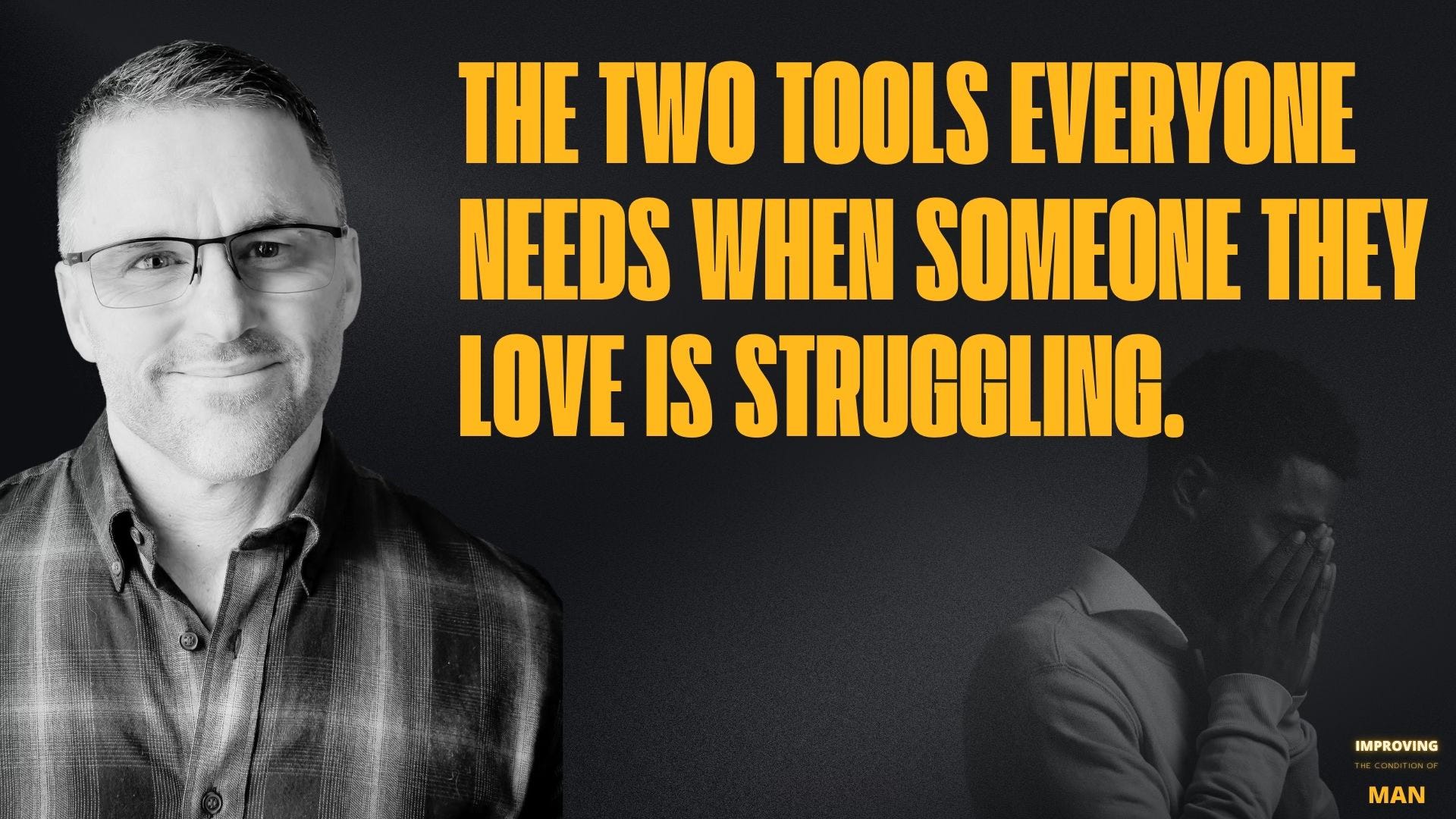How to Show Up Without Blowing It
The two tools everyone needs when someone they love is struggling.
WHAT THE HELL I’M DOING HERE
I’ve been thinking a lot about the purpose I want my Substack to serve. Obviously, I want it to serve as a platform where I can share my thoughts with whoever deems them worthy of reading. I also want to help men, and the people who love them, navigate grief after a devastating loss. Since I also fall into that category, my writing helps me as much as anyone else.
I recently became obsessed with growing my subscriber base. I tend to get hyper fixated on things and this was the latest incarnation of those tendencies. I convinced myself that I had an obligation to grow my audience in the service of helping as many people as possible. There’s a still a certain logic in that idea that resonates with me.
I started devouring authors, and there are many, who teach you how to grow and monetize your Substack. I put many of the practices in place, created a few low-ticket offers and started seeing results. I grew my list by over a thousand subscribers in short order and sold a few things to people.
And it felt like shit. I noticed myself starting to write in a way that was designed to get people to click rather than speaking with my own voice. I started to get disappointed on the days I didn’t sell anything. Before long, it started to seem like work where before it seemed important.
That’s not to say I what I was selling wasn’t valuable. I think the tools I created are very important and can quickly and dramatically improve people’s ability to communicate with and support the people they love most - especially when they are hurting. I’ve taught them to thousands of people over the years with life-changing impact. I’m super passionate about getting them into people’s hands.
So here’s the pivot: I’m going to stop selling them and give them away. I want you to try them, share them and put them into practice. If you do, I promise you that you’ll be able to communicate more effectively at home, at work and anywhere else you talk to another human being.
WHERE WE GO WRONG
When someone you love is grieving—or going through anything heavy—most of us do one of two things:
We either avoid the conversation entirely, or we come in hot and blow it up.
Neither one works. Both usually make things worse.
I know because I’ve done both more times than I can count. I used to think the goal of a hard conversation was to win. Now I know: if one of you loses, you both do.
What I didn’t know back then? No one ever taught me how to talk to someone who’s hurting. I had no clue how to validate what they were feeling, or how to speak in a way they could actually hear. So I did what most people do—I fumbled through it and left a trail of wreckage.
But it doesn’t have to be that way. There are better tools. And once you learn them, you’ll stop making things worse, and start making real connection possible again.
Here are the two most important tools I’ve found.
1. Speak From “I” (Not From Judgment)
I’ve created an interactive coach where you can practice this skill before addressing an important issue with someone. You can use it completely free, no strings attached, at the link below:
Read the full article here:
How to Have the Hard Conversations Grief Makes Even Harder
I used to be the king of zero-sum communication. If I had to address an issue, I felt like I needed to win—which meant the other person had to lose. It took me a pathetically long time to realize that if they lose, we both lose.
Grief and other hard emotions turn even simple conversations into landmines. Emotions are jacked up, patience is thin, and your brain is scanning for threats—so it defaults to black-and-white thinking. You assume the worst. You speak in absolutes. And suddenly you're in a fight you didn’t mean to start.
The solution?
Slow down. Get clear. Speak from your experience—not your assumptions.
That’s where the Experience Cube comes in. It’s a four-part framework that helps you avoid blaming, assuming, or exploding. Before you open your mouth, break things down like this:
Observation – What did you actually see or hear? (“I noticed you’ve been quiet lately.”)
Thought – What story are you telling yourself about it? (“I’ve been wondering if you’re overwhelmed or trying to push me away.”)
Feeling – What emotions are coming up for you? (“I feel disconnected and unsure of how to show up for you.”)
Want – What do you actually need? (“I’d like to understand how you’re doing and what you need right now.”)
This isn’t about sounding nice. It’s about being effective.
An “I” statement keeps you in your lane. It invites conversation instead of shutting it down. It makes room for both of you to exist in the hard stuff without turning it into a battle.
2. Validate What They’re Feeling (Before You Try to Fix Anything)
I’ve created an interactive coach where you can practice being effective in supporting someone who’s upset (without making it worse). You can use it completely free, no strings attached, at the link below:
If you want the full course on Emotional Validation you can grab it below. It’s $1 - I will make it free as soon as I’m done migrating it out of the platform it’s on. It’s more work than I thought!
Read the full article here:
The 10 Things You Say That Hurt More Than They Help
Picture this: Someone you love is grieving. You want to help, so you say, “Stay strong. They’d want you to be happy.”
Most people suck at this—not because they’re heartless, but because they’ve never seen it done well. We’re taught to solve problems, find silver linings, or avoid uncomfortable feelings altogether.
But when someone is hurting, they don’t need a solution. They need to feel seen.
Enter the LEAD Model, a dead-simple way to validate someone else’s emotional experience—without overthinking it or stepping in it.
L – Label the Emotion
“This seems really heavy.”
“It sounds like this is eating you alive.”
“I imagine this has been a lot.”E – Explore Their Experience
Stay curious, not interrogating. Ask:
“What’s been the hardest part for you?”
Or mirror something they said:
“Overwhelming?”A – Acknowledge It
“It makes sense you’d feel that way.”
“Anyone in your shoes would be feeling this too.”D – Decide What to Do Next
This is where you either hold space or ask what they need.
“Do you want to talk more about it or just sit here for a bit?”
“Would it help if I shared a thought, or do you just need to vent?”
Sometimes the most helpful thing you can do is nothing at all. Just be there, grounded, and present while they feel what they feel.
Final Thought:
Most of us never got the manual on how to do this. But once you learn these tools—speaking from “I” and validating with LEAD—you’ll stop walking on eggshells, blowing things up, or accidentally pushing people away when they need you most.
You don’t need to say it perfectly. You just need to show up differently.
That’s how you stop making it worse—and start making it safe for real connection again.







This is really, really, really good. I process verbally, and am married to a partner who processes internally--deeply. All of your suggestions/tools are very, very effective. (I just learned & used the LEAD model. Highly emotional situation. It helped. A LOT.) So, thank you, thank you. And I heartily support and celebrate your recalibration to your Center. --a fellow SubStacker
Thank you so much for your work, Jason. ❤️ I am both sad and glad that you’ve gone through what you’ve gone through to be able to write about this in such a helpful way. (I hope that makes sense in the way that I mean for it to).
The Difficult Conversations Coach is amazing. In just a few sentences, it’s already helped me get clarity around how to handle a situation that has been weighing heavily on me for months.
I also wanted to try the Emotional Validation coach, but it doesn’t seem to be working. I will 100% get the course, though.
Your work is fantastic. Thank you!